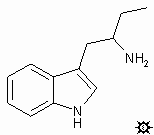


|
| [3D .mol structure] |
This is the exact wording of the law, and I have discovered that the more times I read it the more convinced I become that, whatever the original intent might have been, it was structured in a way to promote vagueness. I have written elsewhere about the rhetorical nightmare of a double disclaimer, "substantially similar." "Similar" means "pretty much the same." "Substantially identical" would means "pretty much the same." But what does "substantially similar" mean? I like the analogy of seeing two cut glass shakers in the center of the fancy table, one with small holes in the silver screw-down cap containing salt, and the other with slightly larger holes containing pepper. Are these two items substantially similar? If you happen to be a collector of antique crystal glassware, these items are completely identical. If you happen to need to add a condiment to your entree these items are totally different. You must know whose eyes are being looked through to approach the question of "substantial similarity." At a trial a few years ago in Southern California the issue was settled once and for all for a confused jury when a forensic chemist gave an expert opinion that two things were substantially similar when they were greater than 50% identical. Is the right hand more than 50% identical to the right foot? This opinion was patently absurd.(32)(A) Except as provided in subparagraph (B), the term 'controlled substance analogue' means a substance --
(i) the chemical structure of which is substantially similar to the chemical structure of a controlled substance in Schedule I or II;
(ii) which has a stimulant, depressant, or hallucinogenic effect on the central nervous system that is substantially similar to or greater than the stimulant, depressant, or hallucinogenic effect on the central nervous system of a controlled substance in Schedule I or II; or
(iii) with respect to a particular person, which such person represents or intends to have a stimulant, depressant, or hallucino-genic effect on the central nervous system that is substantially similar to or greater than the stimulant, depressant, or hallucinogen effect on the central nervous system of a controlled substance in schedule I or II.
(B) Such term does not include --
(i) a controlled substance;
(ii) any substance for which there is an approved new drug application;
(iii) with respect to a particular person any substance, if an exemption is in effect for investigational use, for that person, under section 505 of the Federal Food, Drug, and Cosmetic Act (21 U.S.C. 355) to the extent conduct with respect to such substance is pursuant to such exemption; or
(iv) any substance to the extent not intended for human consumption before such an exemption takes effect with respect to that substance.
SEC. 203. A controlled substance analogue shall, to the extent intended for human consumption, be treated, for purposes of this title and title III as a controlled substance in Schedule I.
| HTML and Design by Bo & Erowid | Used by Erowid with permission of author |